SIAMESE cooperates with the CDH1-like protein CCS52A1 to establish endoreplication in Arabidopsis thaliana trichomes
- PMID: 20194967
- PMCID: PMC2870961
- DOI: 10.1534/genetics.109.113274
SIAMESE cooperates with the CDH1-like protein CCS52A1 to establish endoreplication in Arabidopsis thaliana trichomes
Abstract
Endoreplication, also known as endoreduplication, is a phyogenetically widespread modified version of the cell cycle in which DNA replication is not followed by cell division. The SIAMESE (SIM) gene of Arabidopsis thaliana encodes the founding member of a novel class of plant-specific cyclin-dependent kinase (CDK) inhibitors and is a key regulator of endoreplication during the development of trichomes (shoot epidermal hairs). Here, we have identified mutations in the CCS52A1 gene as genetic modifiers of the multicellular trichome phenotype of sim mutants. Loss-of-function ccs52A1 mutations dramatically enhance the multicellularity of sim mutants trichomes in double mutants, whereas overexpression of CCS52A1 completely suppresses the sim mutant phenotype. CCS52A1 encodes a CDH1/FZR-like protein, a class of proteins that function as activators of the anaphase-promoting complex. Unicellular ccs52A1 trichomes become multicellular upon overexpression of B-type cyclin, consistent with repression of the accumulation of mitotic cyclins in the developing trichome by CCS52A1. As these M-phase-specific cyclins are known to accumulate in sim mutant trichomes, our data suggest that CCS52A1 and SIM cooperate in repressing accumulation of mitotic cyclins to establish the trichome endocycle. Comparison with endoreplication pathways in Drosophila and mammals indicates that while these organisms all use similar components to initiate endoreplication, the components are deployed differently in each organism.
Figures
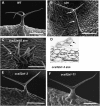
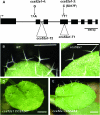
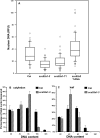

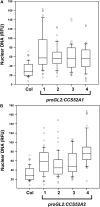
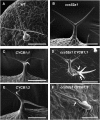

Similar articles
-
GIGAS CELL1, a novel negative regulator of the anaphase-promoting complex/cyclosome, is required for proper mitotic progression and cell fate determination in Arabidopsis.Plant Cell. 2011 Dec;23(12):4382-93. doi: 10.1105/tpc.111.092049. Epub 2011 Dec 13. Plant Cell. 2011. PMID: 22167058 Free PMC article.
-
SIAMESE, a plant-specific cell cycle regulator, controls endoreplication onset in Arabidopsis thaliana.Plant Cell. 2006 Nov;18(11):3145-57. doi: 10.1105/tpc.106.044834. Epub 2006 Nov 10. Plant Cell. 2006. PMID: 17098811 Free PMC article.
-
The CDK Inhibitor SIAMESE Targets Both CDKA;1 and CDKB1 Complexes to Establish Endoreplication in Trichomes.Plant Physiol. 2020 Sep;184(1):165-175. doi: 10.1104/pp.20.00271. Epub 2020 Jul 21. Plant Physiol. 2020. PMID: 32694133 Free PMC article.
-
Trichomes as models for studying plant cell differentiation.Cell Mol Life Sci. 2013 Jun;70(11):1937-48. doi: 10.1007/s00018-012-1147-6. Epub 2012 Sep 21. Cell Mol Life Sci. 2013. PMID: 22996257 Free PMC article. Review.
-
Endoreplication-Why Are We Not Using Its Full Application Potential?Int J Mol Sci. 2023 Jul 24;24(14):11859. doi: 10.3390/ijms241411859. Int J Mol Sci. 2023. PMID: 37511616 Free PMC article. Review.
Cited by
-
Combined linkage and association mapping reveals CYCD5;1 as a quantitative trait gene for endoreduplication in Arabidopsis.Proc Natl Acad Sci U S A. 2012 Mar 20;109(12):4678-83. doi: 10.1073/pnas.1120811109. Epub 2012 Mar 5. Proc Natl Acad Sci U S A. 2012. PMID: 22392991 Free PMC article.
-
Dynamics of defense responses and cell fate change during Arabidopsis-Pseudomonas syringae interactions.PLoS One. 2013 Dec 11;8(12):e83219. doi: 10.1371/journal.pone.0083219. eCollection 2013. PLoS One. 2013. PMID: 24349466 Free PMC article.
-
Endocycles: a recurrent evolutionary innovation for post-mitotic cell growth.Nat Rev Mol Cell Biol. 2014 Mar;15(3):197-210. doi: 10.1038/nrm3756. Nat Rev Mol Cell Biol. 2014. PMID: 24556841 Review.
-
AaCycTL Regulates Cuticle and Trichome Development in Arabidopsis and Artemisia annua L.Front Plant Sci. 2021 Dec 23;12:808283. doi: 10.3389/fpls.2021.808283. eCollection 2021. Front Plant Sci. 2021. PMID: 35003194 Free PMC article.
-
Local endoreduplication of the host is a conserved process during Phytomyxea-host interaction.Front Microbiol. 2025 Feb 5;15:1494905. doi: 10.3389/fmicb.2024.1494905. eCollection 2024. Front Microbiol. 2025. PMID: 39974374 Free PMC article.
References
-
- Araki, S., M. Ito, T. Soyano, R. Nishihama and Y. Machida, 2004. Mitotic cyclins stimulate the activity of c-Myb-like factors for transactivation of G2/M phase-specific genes in tobacco. J. Biol. Chem. 279 32979–32988. - PubMed
-
- Boudolf, V., D. Inze and L. De Veylder, 2006. What if higher plants lack a CDC25 phosphatase? Trends Plant Sci. 11 474–479. - PubMed
-
- Caro, E., and C. Gutierrez, 2007. A green GEM: intriguing analogies with animal geminin. Trends Cell Biol. 17 580–585. - PubMed
Publication types
MeSH terms
Substances
LinkOut - more resources
Full Text Sources
Molecular Biology Databases
Research Materials
Miscellaneous

